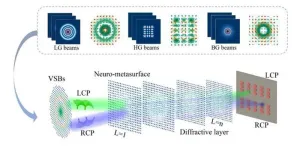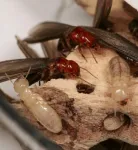(Press-News.org)
One of Earth’s most consequential bursts of biodiversity—a 30-million-year period of explosive evolutionary changes spawning innumerable new species—may have the most modest of creatures to thank for the vital stage in life’s history: worms.
The digging and burrowing of prehistoric worms and other invertebrates along ocean bottoms sparked a chain of events that released oxygen into the ocean and atmosphere and helped kick-start what is known as the Great Ordovician Biodiversification Event, roughly 480 million years ago, according to new findings Johns Hopkins University researchers published in the journal Geochimica et Cosmochimica Acta.
“It’s really incredible to think how such small animals, ones that don’t even exist today, could alter the course of evolutionary history in such a profound way,” said senior author Maya Gomes, an assistant professor in the Department of Earth and Planetary Sciences. “With this work, we’ll be able to examine the chemistry of early oceans and reinterpret parts of the geological record.”
To better understand how changes in oxygen levels influenced large-scale evolutionary events, Gomes and her research team updated models that detail the timing and pace of increasing oxygen over hundreds of millions of years.
They examined the relationship between the mixing of sediment caused, in part, by digging worms with a mineral called pyrite, which plays a key role in oxygen buildup. The more pyrite that forms and becomes buried under the mud, silt, or sand, the more oxygen levels rise.
Researchers measured pyrite from nine sites along a Maryland shoreline of the Chesapeake Bay that serves as a proxy for early ocean conditions. Sites with even just a few centimeters of sediment mixing held substantially more pyrite than those without mixing and those with deep mixing.
The findings challenge previous assumptions that the relationship between pyrite and sediment mixing remained the same across habitats and through time, Gomes said.
Conventional wisdom held that as animals churned up sediments by burrowing in the ocean floor, newly unearthed pyrite would have been exposed to and destroyed by oxygen in the water, a process that would ultimately prevent oxygen from accumulating in the atmosphere and ocean. Mixed sediments have been viewed as evidence that oxygen levels were holding steady.
The new data suggests that a small amount of sediment mixing in water with very low levels of oxygen would have exposed buried pyrite, sulfur, and organic carbon to just enough oxygen to kick-start the formation of more pyrite.
“It’s kind of like Goldilocks. The conditions have to be just right. You have to have a little bit of mixing to bring the oxygen into the sediment, but not so much that the oxygen destroys all the pyrite and there’s no net buildup,” said Kalev Hantsoo, a doctoral candidate at Johns Hopkins and first author on the article.
When the researchers applied this new relationship between pyrite and the depth of sediment mixing to existing models, they found oxygen levels stayed relatively flat for millions of years and then rose during the Paleozoic era, with a steep rise occurring during the Ordovician period.
The extra oxygen likely contributed to the Great Ordovician Biodiversification Event, when new species rapidly flourished, the researchers said.
“There’s always been this question of how oxygen levels relate to the moments in history where evolutionary forces are ramped up and you see a greater diversity of life on the planet,” Gomes said. “The Cambrian period also had a massive speciation event, but the new models allow us to rule out oxygen and focus on other things that may have driven evolution during that time.”
END
The recent surge in popularity of AI tools such as ChatGPT is forcing the science community to reckon with its place in scientific literature. Prestigious journals such as Science and Nature have attempted to restrict or prohibit AI use in submissions, but are finding it difficult to enforce because of how challenging it is becoming to detect machine-generated language.
Because AI is getting more advanced at mimicking human language, researchers at the University of Chicago were interested in learning ...
In the dynamic realm of optical physics, researchers are continually pushing the boundaries of how light can be manipulated and harnessed for practical applications. As reported in Advanced Photonics Nexus, a groundbreaking study from the Harbin Institute of Technology (HIT) introduces a method for sorting and distinguishing various types of vector structured beams (VSBs), promising significant advancements in optical communication and quantum computing.
Unlike conventional light beams that propagate in simple, straight trajectories, VSBs are engineered to form complex, intricate patterns. These beams transmit ...
Mainly older and middle-aged women, working class, with a very high prevalence of lower back pain and consequently possible psycho-affective problems and a poorer quality of life... This is the general profile of carers of the elderly. Who cares for the carer? This question or demand is not new in our society. Members of the Ageing On research group of the University of the Basque Country (UPV/EHU) asked themselves the following question: “How can we care for the carers?”
The Ageing On group develops, ...
Polygenic risk scores (PRSs) are estimates of an individual’s susceptibility to a specific complex trait obtained by aggregating the effects of dozens, thousands, and potentially millions of genetic variants associated with that specific trait into a single figure. Some private companies now market PRS embryo screening to prospective parents through the use of in vitro fertilisation and pre-implantation genetic testing. While PRS has great potential for prediction in live-born (mostly adult) individuals, its accuracy ...
Berlin, Germany: Cancer is the leading cause of disease-related death in children in most developed countries, and at least a quarter of these patients are diagnosed with aggressive high-risk or relapsed cancers, with an expected five-year survival rate of less than 30%. Accurate diagnosis can be difficult, and survivors often suffer life-long side effects because of the toxic treatments needed to cure them. Now, researchers from Australia have shown that, by using precision medicine*, it is possible not only to obtain more accurate diagnoses, but also that using precision-guided, targeted treatments earlier improves the two year progression-free ...
In May 2022, the Facility for Rare Isotope Beams (FRIB) at Michigan State University (MSU), launched its precision measurement program. Staff from FRIB’s Low Energy Beam and Ion Trap (LEBIT) facility take high-energy, rare-isotope beams generated at FRIB and cool them to a lower energy state. Afterward, the researchers measure specific particles’ masses at high precision.
The LEBIT team, led by Ryan Ringle, adjunct professor of physics at FRIB and in the MSU Department of Physics and Astronomy and senior ...
UC Riverside scientists have discovered a highly effective, nontoxic, and less expensive way to lure hungry termites to their doom.
The method, detailed in the Journal of Economic Entomology, uses a pleasant-smelling chemical released by forest trees called pinene that reminds western drywood termites of their food. They follow the scent to a spot of insecticide injected into wood.
“We saw significant differences in the death rates using insecticide alone versus the insecticide plus pinene,” said UCR entomologist Dong-Hwan Choe, who led the discovery. “Without pinene, we got about 70% mortality. When we added it in, it was over 95%.
Native ...
The pharmaceutical drug development and approval process is a multi-step undertaking that requires a plethora of testing before reaching the market. Even then, humans respond differently to drugs depending on their individual bodies and medical needs.
Dr. Abhishek Jain, associate professor in the Department of Biomedical Engineering, and his lab received a grant from Texas A&M Innovation to continue developing an advanced vessel-chip deployment platform for large-scale pharmaceutical testing services that holds promise for ...
TAMPA, Fla., and PLEASANTON, Calif. — Moffitt Cancer Center, a world-renowned cancer treatment and research center, and Virogen Biotechnology Inc., a clinical-stage biotechnology company, announced a groundbreaking strategic partnership today. This collaboration aims to propel the development of Virogen's cutting-edge fusion protein, VG712 (Resimmune), addressing significant unmet needs in oncology and immunotherapy.
Under this strategic alliance, Moffitt will offer Virogen priority access to ...
About The Study: Ivonescimab plus chemotherapy significantly improved progression-free survival with tolerable safety profile in patients with non–small cell lung cancer who previously underwent EGFR tyrosine kinase inhibitor (EGFR-TKI) treatment and may offer a new treatment option for patients with TKI resistance.
Quote from corresponding author Li Zhang, M.D.:
“For patients with non-small cell lung cancer whose illness has progressed while receiving EGFR tyrosine kinase inhibitor (EGFR-TKI) therapy, especially the ...




